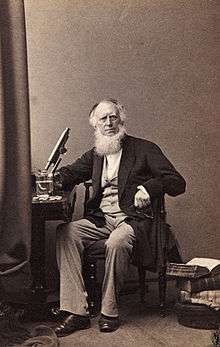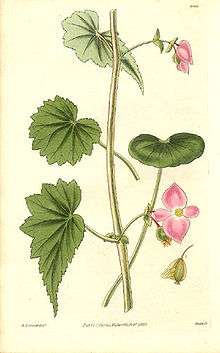Robert Kaye Greville
| Robert Kaye Greville | |
|---|---|
|
Robert Kaye Greville in a detail from an 1840 painting.[1] | |
| Born |
13 December 1794 Bishop Auckland, Durham |
| Died |
4 June 1866 (aged 71) Murrayfield, Edinburgh |
| Resting place | Dean Cemetery, Edinburgh[2] |
| Residence | Ormelie Villa |
| Nationality | British |
| Education | London and Edinburgh |
| Occupation | Academic |
| Known for | Polymath |
| Spouse(s) | Charlotte Eden |
| Children | yes |
| Parent(s) | Rev. Robert Greville, Dorothy Chaloner |


Dr Robert Kaye Greville FRSE FLS LLD (13 December 1794 – 4 June 1866) was an English mycologist, bryologist, and botanist. He was an accomplished artist and illustrator of natural history. In addition to art and science he was interested in causes like abolitionism,[1] capital punishment,[3] keeping Sunday special[4] and the temperance movement. He has a mountain in Queensland named after him.[5]
Biography

Greville was born at Bishop Auckland, Durham, but was brought up in Derbyshire as his father, Robert Greville, became the rector of the small village of Edlaston and its nearby hamlet of Wyaston.[6] Greville had an interest in these natural history since he was very young, but he originally studied medicine. Realising that he did not need an income he discarded his medical education and concentrated on Botany.
Greville was awarded a doctorate by the University of Glasgow in 1824.[7] He gave a large number of lectures in the natural sciences and built up collections that were bought by the University of Edinburgh.
Greville married William Eden, 1st Baron Auckland's niece Charlotte Eden in 1816. In 1823 he began the illustration and publishing of the journal Scottish cryptogamic flora and also contributed other articles in the field. In addition to science he was interested in political causes like abolitionism,[1] capital punishment,[3] keeping Sunday special[4] and the temperance movement.
In 1828 he received an honour when Mount Greville in Queensland was named in Greville's honour by a fellow botanist, Allan Cunningham. Mount Greville became part of an Australian National park in 1948 and is now part of Moogerah Peaks National Park. The aboriginal name for Mount Greville and the area around it (including Cunninghams Gap) is Moogerah which gave its name to the Park.[5]
In the 1830s he is listed as living at 1 Wharton Place in Edinburgh.[8]

In 1835 Greville published some piano music for a sacred melody written by Rev. W. H. Bathurst.[9] In the following year he served as President of the Botanical Society of Edinburgh for the first time.[4]
In 1840, Greville was one of the four vice-presidents[7] at the World's Anti-Slavery Convention at Freemason's Hall in London on 12 June 1840. The picture above shows him in a detail from a painting made to commemorate the event which attracted delegates from America, France, Haiti, Australia, Ireland, Jamaica and Barbados.[1] The painting now hangs in the National Portrait Gallery in London.
Greville was a member of a number of learned societies including being honorary secretary of the Biological Society and a Fellow of the Royal Society of Edinburgh. He was an honorary member of the Royal Irish Academy and the Howard Society[3] as well as being a corresponding member of natural history societies including Brussels, Paris, Leipzig and Philadelphia.[7] He was secretary of the Sabbath Alliance and a compiler of the Church of England's 1838 hymn book.[4]
Towards the end of his life he created landscape painting which were exhibited.
In 1866 Greville served as President of the Botanical Society of Edinburgh for the second and last time.[4] He died at his home, Ormelie Villa, in Murrayfield, Edinburgh[10] on 4 June 1866 whilst still taking an active interest in his work having new papers in preparation for publication.[7] He is buried in Dean Cemetery on the west side of Edinburgh.[10] The grave lies in the westmost of the two central southern secttions.
Family
He married Charlotte Eden on 17 October 1816 in Bishop Auckland, Durham.[11]
Robert Kaye Greville and Charlotte Greville (née Eden)[10] had 3 sons, Robert Northmore Greville, Eden Kaye Greville and Chaloner Greville and three daughters. Charlotte Dorothea Greville married the Rev. David Hogarth on 3 April 1857.[12]
Journals
| Wikimedia Commons has media related to Robert Kaye Greville. |
- Flora Edinensis (1824)[13]
- Tentamen methodi Muscorum (1822–1826)
- Icones filicum or Figures and Descriptions of Ferns (1830) (with Sir W. J. Hooker)[14]
- Scottish cryptogamic flora (1822–1828)[15]
- Algae britannicae (1830)
- Facts illustrative of the drunkenness of Scotland with observations on the responsibility of the clergy, magistrates, and other influential bodies (1834)[2]
- Slavery and the slave trade in the United States of America; and the extent to which the American churches are involved in their support.,[16] 1845, Edinburgh
References
- 1 2 3 4 The Anti-Slavery Society Convention, 1840, Benjamin Robert Haydon, accessed 19 July 2008
- 1 2 Bio of R.K.Greville, Archives Hub, accessed 5 August 2008
- 1 2 3 The Punishment of Death, Society for the Diffusion of Information on the Subject of Capital Punishments, 1837
- 1 2 3 4 5 Darwin Project biography, accessed 5 August 2008
- 1 2 Moogerah Peaks National Park at Queensland site.
- ↑ Robert Kaye Greville, Mark Lawley
- 1 2 3 4 Obituary, accessed 5 August 2008
- ↑ http://digital.nls.uk/directories/browse/pageturner.cfm?id=83400519&mode=transcription
- ↑ Amazon, sale, accessed 5 August 2008
- 1 2 3 http://www.royalsoced.org.uk/cms/files/fellows/biographical_index/fells_indexp1.pdf
- ↑ http://www.gravestonephotos.com/public/gravedetails.php?grave=73915&scrwidth=1301
- ↑ baronage.co.uk
- ↑ Robert Kaye Greville (1824). Flora Edinensis: Or, A Description of Plants Growing Near Edinburgh, Arranged According to the Linnean System, with a Concise Introduction to the Natural Orders of the Class Cryptogamia, and Illustrative Plates. W. Blackwood.
- ↑ Icones Filicum, by Greville and Hooker, whole book on-line, accessed 5 August 2008
- ↑ Robert Kaye Greville (1825). Scottish cryptogamic flora, or Coloured figures and descriptions of cryptogamic plants, belonging chiefly to the order Fungi and intended to serve as a continuation of English botany. Printed for Maclachlan & Stewart.
- ↑ Drawn up at the request of the committee of the Edinburgh Emancipation Society
- ↑ IPNI. Grev.
